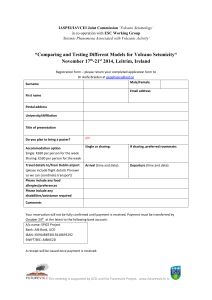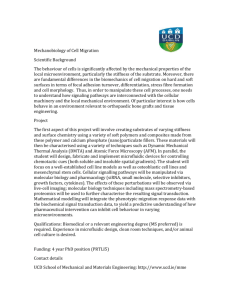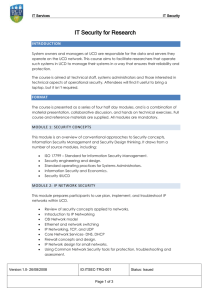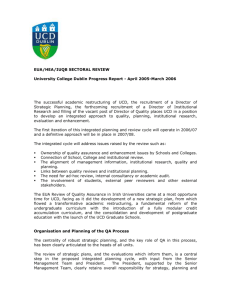IT Strategy Review 2014 ppt
advertisement
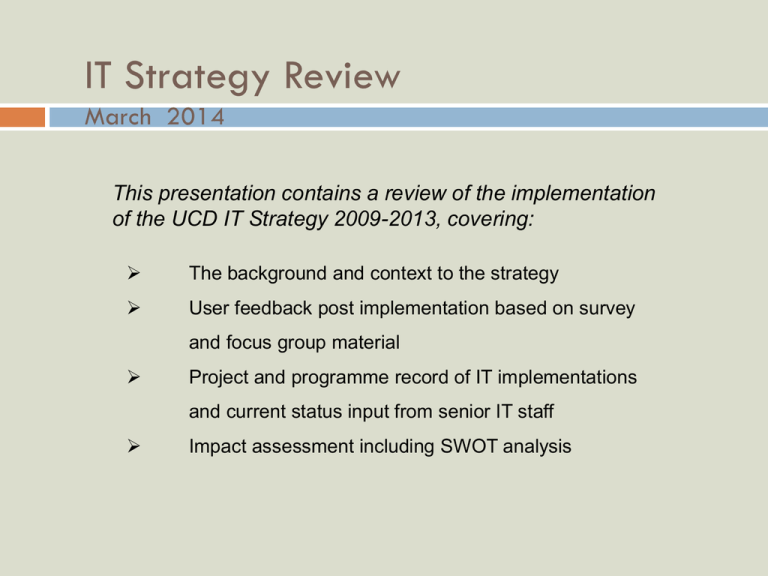
IT Strategy Review March 2014 This presentation contains a review of the implementation of the UCD IT Strategy 2009-2013, covering: The background and context to the strategy User feedback post implementation based on survey and focus group material Project and programme record of IT implementations and current status input from senior IT staff Impact assessment including SWOT analysis Background & Context to the IT Strategy INTERNAL EXTERNAL Large growth in IT service use in UCD Cloud platforms (& utility IT) Reduction in budget of circa 7% p.a. Social Media platforms Tech staff attrition to external posts (IT Services 26 leavers, 12 joiners since 2008) Consumerisation of IT Smart phones & tablets “Big Data” trends MOOCs & on-line courses Inter-Institutional Collaboration Very high user adoption of services – UCD Connect & Blackboard Out-sourcing of major services – Google, Blackboard & Helpdesk Modularisation “Horizons” program Shared service developments Internationalisation of UCD Economic downturn Growth of Post-Grad & Research Increased competition Campus Expansion & New buildings Information demand for planning and accountability Service Growth - The number of wireless users on the network has grown massively since 2007 – from equal wired/wireless, to 5 x times more wireless. The total devices on the network in a given month is now over 60,000 In the same period the overall UCD budget spend on IT has decreased by 25% from 11.4 mil Euro in 2008 to 8.5 mil Euro in 2014. Profile of Investment & Performance User Feedback – UCD Staff Amárach Report IT Satisfaction Level - survey “Review how UCD staff interact with IT services” Overall satisfaction with IT services is high among stakeholders. For services which are used regularly and everyday satisfaction is very high. (90% satisfied) 25 Across the board stakeholders felt that the organisation was well up to date in terms of technology and updating it’s systems. 99% of stakeholders identified reliability as being the most important aspect of IT services Access to face to face support (41%) and 24 hour access to services (60%) are two areas where stakeholders felt that IT services were performing least well 58 Very satisfied (25%) Satisfied (58%) Neither/Nor (12%) 12 4 1 Unsatisfied (4%) Very unsatisfied (1%) User Feedback – Research Foresight A study with focus group was carried out by the Research Office in Oct 2013 Current Service Feedback Future Requirements A series of focus groups with research users found overall high satisfaction with Research IT The expertise of the Research IT team was positively commented on The network, hosting, and HPC services, including ICHEC are meeting UCD demand The network infrastructure is now seen as very robust and reliable Storage costs are still regarded as very high by research users The need for more advanced services was identified, suggesting Research requirements are moving to a new level Expert advisory services - Three areas of need were identified – GIS, Digital Arts & Humanities, and Personalised Medicine IT services should include the provision of web design, development, & hosting Video conferencing & podcasting supports need to be provided as a service Requirement to provide access to datasets from publicly funded research Data Management Services are essential Strategy Objectives & Implementation There were 5 key objectives in the IT Strategy Sustaining IT Infrastructure & Performance Enhancing user experience & access to information Building a Collaborative Data Centre Implementing Classroom Technology & Learning Spaces Growing eContent and Data Management Capability The implementation of each objective is summarised in the following slides, with a strength/weakness assessment Strategy Objectives & Implementation 1. Sustaining IT Infrastructure & Performance Strength / DELIVERY Target availability met 99.5% Network very strong – both measured & user feedback Infrastructure delivered with a much reduced budget On campus dual Data Centre effective, with low cost profile Strong technical team Effective move to out-sourcing & virtual/cloud models Large savings in storage and support from Gmail / Google outsourcing Weakness / GAP Aspiration to further increase availability (99.9%), not possible Investment level is very low (UCD 2.5% income vs. 4.4% benchmark) Meeting future demand may be difficult Storage cost for Research viewed as expensive ( currently a full cost recovery model is used ) Attrition of skills to external market is a threat – concentrated in technical teams Strategy Objectives & Implementation 2. Enhancing user experience & access to information Strength / DELIVERY UCD Connect – platform of choice for users, with high satisfaction Web interfaces for staff to admin systems implemented : +ive feedback. Off-campus access and mobile services delivered – with strong adoption Technology in classrooms rolled out Research services – compute & support delivered, with high satisfaction Management Information delivered through InfoHub for staff Content management system implemented for UCD web site Identity management implemented Weakness / GAP Office automation solution not yet finalised or implemented Research demand is now for more specialised advisory services Customer awareness of some services could be improved Some Figures 60% off campus use of UCD Connect 200+ web sites use CMS 60,000 campus wireless devices 30,000 mobile downloads UCD app Strategy Objectives & Implementation 3. Building a Collaborative Data Centre Strength / DELIVERY Interim option to expand Daedalus centre was implemented Data centres on campus provided necessary capacity for the duration of the strategy, with DR in-built ICHEC high performance compute was hosted in Daedalus Cost effective & high efficiency model was implemented for campus DCs UCD new investment in ICHEC condo & in-house cluster provides for research Future out-sourcing options for second DC are under review Weakness / GAP Plan for national data centre on UCD campus not funded Future capacity needs to be sourced to meet demand – flexible & agile option Priority to meet UCDs strategic & research objectives DR and failover option required, when/if older campus DC shuts down (campus development plan) Data Centre transition is a high risk project with service implications Strategy Objectives & Implementation 4. Implementing Classroom Technology & Learning Spaces Strength / DELIVERY Standard model for classrooms agreed and implemented with B&S Rolled out to all “bookable” rooms Support model agreed and implemented User interface, podium, PC and technology are all easily used External support contract for hardware is in place Positive feedback from staff Daedalus equipped with smartboards, videoconference & multi-functional spaces Weakness / GAP Lecture capture facilities are still only used by a few – 10% Extend technology standards to all classrooms Continue discussion & interaction on design of new spaces / buildings Ensure long term maintenance of the new model Strategy Objectives & Implementation 5. Growing eContent and Data Management Capability Strength / DELIVERY Weakness / GAP Research Data Plan developed on data management model with Research IT group Output used with Library for future work on data management Advisory / training on data security Learning Content Templates in Blackboard for course delivery. Educational technologists based in schools ( 14/15 ) UCD initiative for on-line courses Some progress on research data management & analytics, but requirement for this is escalating Demand for research for advisory service around data not fully met (apart from data security area ) Limited involvement in MOOC trials and new public learning platforms ( Futurelearn, Udacity, Coursera etc..) Impact Assessment Opportunities Build on high user adoption – capacity to deliver services on a wider scale, international and inter-institutional Strong learning platform with capability to deliver wide range of services – could work in parallel with MOOC presence (for marketing - see Edinburgh e.g. ) Transition to a cloud model with out-sourcing and brokered services, would give high agility Research storage – secure /cloud capacity possible – some subvention may be required to drive adoption Incentives & support to use lecture capture – e.g. Tutorial “10min” lecture element service Threats Research capability – stronger service and skills required in data management & analytics DC capacity and higher availability required for “consumer” type service model Underinvestment could severely damage the service IT Skills attrition is a high risk Strategy Summary Impact The significant impacts of the IT Strategy were: Greatly improved satisfaction with user interfaces and access to information services, reflected in high adoption rates and feedback. Strong performance of infrastructure and high confidence in the user community of availability of services – reflected both in general feedback & also from research community, who have very high demands. A strong eLearning platform base, with high use and the potential for growth into a more sophisticated delivery model. Transformation in working model in the University from paper based to on-line Major objectives of the strategy were met despite a very constrained financial environment. Very strong capability to service mobile devices and off campus access – meeting the changing needs of the student population. Contribution to UCD Strategy Learning: IT Systems and Services provided the critical platform to support UCD’s modularised curriculum and blended learning model. Student information, registration, and on-line module selection were essential. The Blackboard learning platform and classroom technology services are key enablers of blended learning, with high adoption and ease of use. Research: Computation and storage are essential elements of the research infrastructure, supporting UCD’s research intensive & inter-disciplinary strategy. The IT Research Team model provided a customer focused service supporting collaboration and the use of Research IT across all disciplines. Platforms delivered by the IT Strategy are providing long term research infrastructure. Innovation & Collaboration: UCD’s portal based IT services and integrated systems provided a very flexible environment for multi-institutional collaboration. Very effective in supporting the Innovation Alliance and new strategic partnerships. Student Experience: High quality on-campus IT, with extended Mobile and “anywhere/anytime” services match student demand & enhance the experience. UCD IT Strategy Review – Overall SWOT Strengths • • • • • • • Very High User adoption of services Very strong customer satisfaction Flexible “anywhere” access (60/40) Good infrastructure base – robust, scalable Shared Application Standards – BlackBoard, Connect, Gmail, CMS, InfoHub Good Research capacity – storage/compute Wireless network & support for mobile Weaknesses • • • • Next stage DC infrastructure, not yet in place – off/on campus ( high risk ) eContent & data management – initial model in place, development required 24/7 support model & higher availability needed to meet future demand Complexity in wider application base Opportunities Threats • • • • • • • Build on high user satisfaction to broaden services & enable UCD initiatives UCD online & public T&L delivery models Transition to cloud model & brokered services for greater agility Initiatives & incentives for eLearning (lead)Shared initiatives for Research IT • • Attrition of technical staff Research requirements for more advanced services need to be met to retain users Under-investment in IT Explosion in devices & internet of things – access risk exposure, even greater wireless capacity requirements

